Vegan sambal tumis recipe. This sweet and slightly spicy hot sauce is both a condiment and a side dish and is perfect with Nasi Lemak.
Estimated reading time: 8 minutes
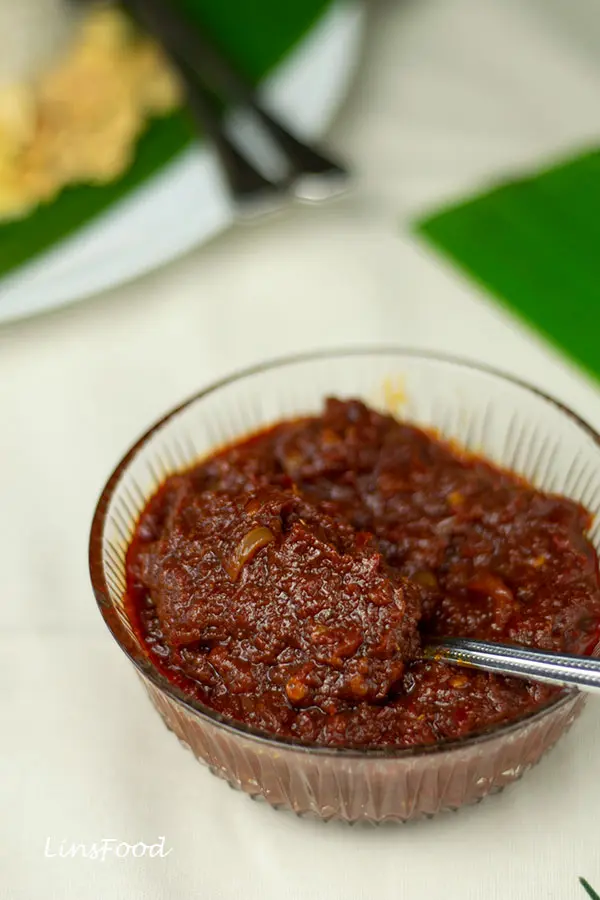
What is Sambal Tumis?
Let’s break it down, shall we?
Sambal
Pronounced some – bal, broad a in both syllables, like in far.
You’ll know by now that this Malay/Indonesian word doesn’t have a direct English translation. It can be a condiment like sambal matah or sambal belacan or a side dish like sambal goreng and our last recipe, sambal sardin. It can dry, and it can also be a wet dish.
Whatever its composition or manifestation, it is almost always on the spicy side. That can be mildly spicy or very spicy.
Tumis
Pronounced tu – mace.
Tumis is a word that describes the frying of something in oil or perhaps even in coconut cream or fat. More often than not, it is the former.
However, we are not talking about things like fried chicken or fried fish. The frying here is akin to sautéing or tempering. Or, like in today’s recipe, the long-ish cooking of a spice or chilli paste.
So sambal tumis is a sambal that’s been fried for a long while. This could be 20 minutes, 30 minutes, or like this red chilli paste on LinsFood, an hour.
Vegan Sambal Tumis
I’ve had many, many questions about this since I started SMR almost 3 years ago. The main query or confusion is always over the use of dried anchovies, or ikan bilis, in Malay. To use or not to use, when making sambal tumis.
The answer is simple: you can if you want to, or leave out the anchovies if you prefer. In Singapore and Malaysia, this is a matter of preference. Folks will chop and change as they fancy.
In my grandma’s kitchen, we would almost always have the simpler version, today’s vegan sambal tumis. This was definitely the case for the nasi lemak that we made to be sold. You can read about that, and get the nasi lemak recipe here.
Occasionally, we’d have the one with anchovies ground up, that sambal tumis recipe will be found on the nasi lemak page.
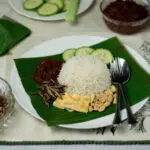
The advantage in today’s recipe is if you can’t get dried anchovies where you are, you can still enjoy a good old sambal tumis the way you had it as a kid in Singapore or Malaysia.
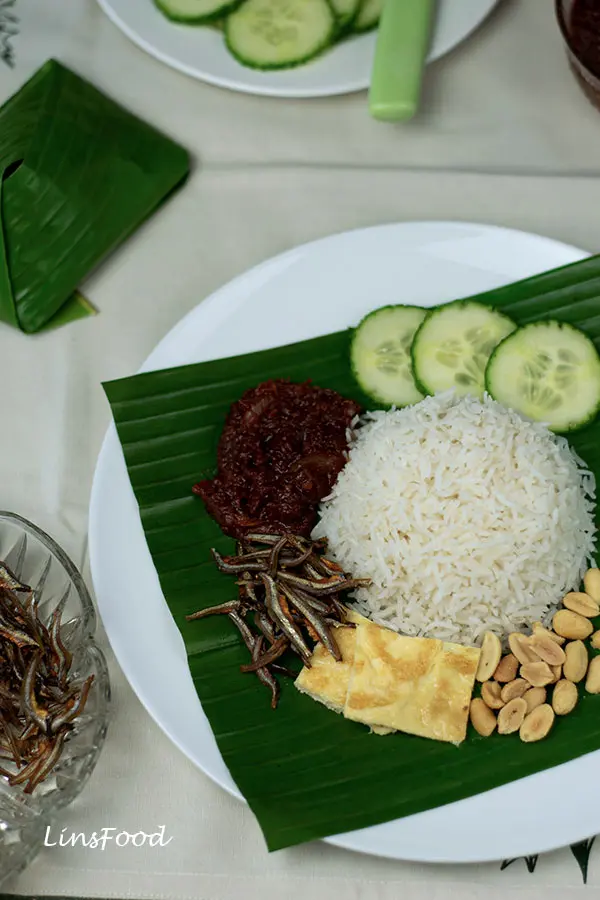
The Recipe
Homemade sambal tumis is very easy to make. This is what we’ll be doing:
- Soak the chillies and tamarind (if using tamarind pulp).
- Blend everything up into a smooth paste, keeping aside some sliced onions.
- Fry the blended red chilli paste in oil for 20 minutes, until the pecah minyak stage (see below).
- Add tamarind and gula melaka (palm sugar) and sliced onions and cook for a few more minutes.
That’s it.
What is Pecah Minyak?
Pecah Minyak is the point where our chilli paste completely loses its raw taste and changes from an emulsion to a distinct oil and paste mix. In English, this would be called oil separation or oil splitting. It’s a principle that’s used in many cuisines, not just Malay and Nyonya cooking.
However, how obvious this separation is and how long it takes for the pecah minyak stage depends on the amount of oil used, the water and the heat.
15 – 20 minutes is a good range, with 15 being one that uses more oil, and 20 or even 25, less oil and more water (when blending).
If you’re not sure about when to stop, go for 20 minutes, even if you have to add a splash of water because it’s getting too dry.
Look out for a full post on it soon.
Ingredients
Most of the ingredients to make vegan sambal tumis are easy to find, although this does depend on where you are. Let’s take a look at some of them, the ones that may need a little explanation.
Dried Red Chillies
Traditionally, we use dried red chillies for cooking sambal tumis, whether that’s for serving with nasi lemak or sambal tumis as a side dish. Always know your chillies before using them. Are they spicy or are they mild? Ask whoever you’re buying them from, they should know.
You want unsmoked dried red chillies, whatever variety you can find will work, even the Mexican ones.
In the recipe card below, I’m giving you a range for the weight (30 – 50g) of the chillies we use. This is because not all dried chillies are the same. I’m using 2 varieties in the sambal here. One is a nameless Chinese variety, that’s fairly spicy, and the other, my homegrown, home dried Kashmiri chillies which are mild.
The Chinese chilli is light, not even registering on my scale when weighed singly. Each dried Kashmiri chilli on the other hand, weighs about 2 grams, give or take. So if your chillies are pretty light, say lighter or similar to a small clove of garlic in weight, then use 30g (1 oz). If each chilli is heavier than a small clove of garlic, then use 50g.
Just bear in mind though, if you’re using a hot variety, your sambal will be hot.
Can you use fresh chillies to make sambal tumis? Sure you can. There will be a slightly lighter flavour to it, but it will be just as delicious. You can compensate for this by adding 125 ml (half a cup) of water with the tamarind, and cooking it for longer.
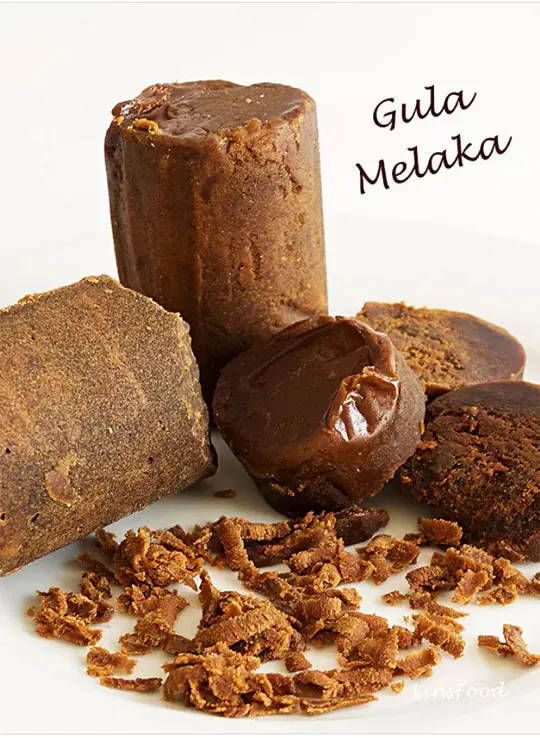
Gula Melaka
The traditional sugar used to sweeten this sambal is gula melaka. It’s a type of palm sugar that is more often than not, made from the coconut palm. It’s much darker in colour and has a more pronounced caramel/toffee flavour and aroma.
So not only does it sweeten our nasi lemak sambal but it also deepens the flavour and darkens it.
Gula Melaka Substitute
You can use the Indian jaggery or a combination of dark brown sugar and white (half each). Don’t use Thai palm sugar, as it’s neither sweet nor dark enough.
And don’t use all brown sugar or molasses because the flavour is just too strong, and you will be messing up the very essence of our sambal tumis.
Tamarind
Click here to read more about tamarind.
Tamarind is a souring agent used around the world. Whether you use tamarind pulp or shop bought paste, it doesn’t matter. I explain amount in the recipe card below.
No tamarind? Generally, the best substitute for tamarind is clear vinegar. Not lime juice nor lemon juice because they will impart a citrus flavour that you might not always want. But for our nasi lemak sambal, yes, you can use lime juice because lime and chillies = match made in heaven!
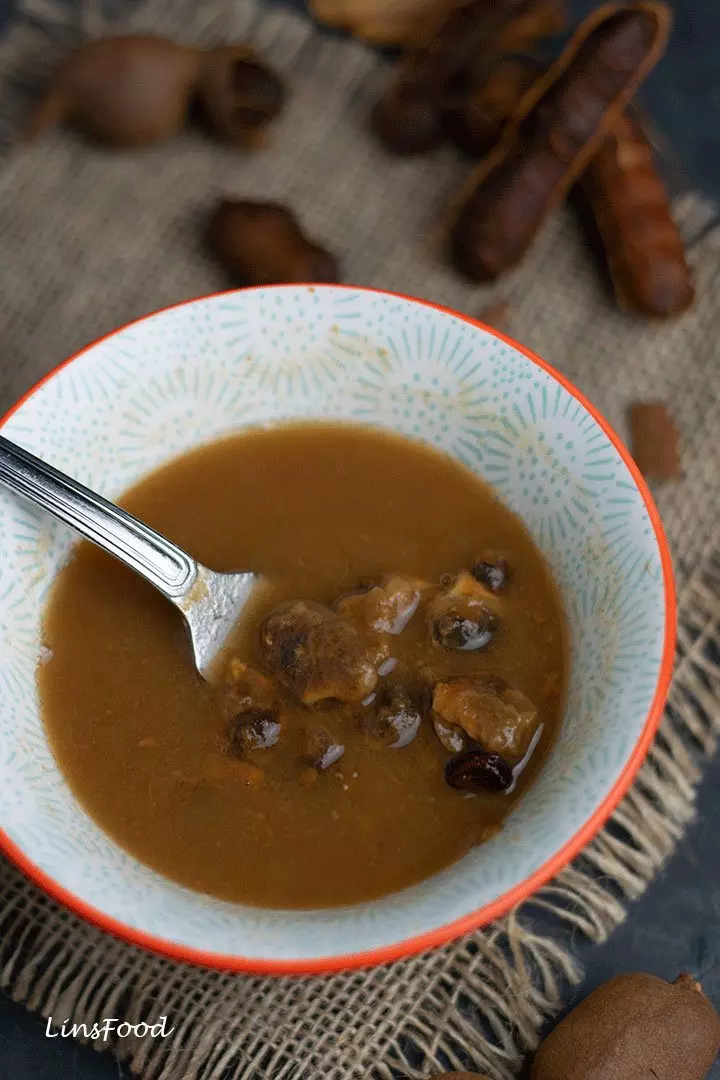
Dark Soy Sauce
Dark soy sauce is another secret culinary weapon for me, like sundried tomato paste in many tomato based dishes. I even add it to dals and Indian curries for that final touch of depth and flavour.
I do the same thing for our sambal nasi lemak. Just half a tablespoon. You could also use sweet soy sauce (kicap manis) if that’s what you have instead.
Dark soy sauce should be easily found next to the more generic light soy sauce in large supermarkets, and most certainly in East Asian stores.
How to Serve Vegan Sambal Tumis?
It makes the perfect accompaniment to nasi lemak, as previously mentioned. Whether you are serving a vegan nasi lemak or not, it doesn’t really matter, as the sambal is only 1 part of the whole. An important part though, so you want to make it rock!
Our sambal tumis can be served as a condiment with any Asian meal, whether that’s rice, noodles or even flatbread like chapati or parata. One of my favourite ways with leftover sambal tumis? As a sandwich spread. So think buttered bread (vegan or otherwise), slather on the sambal tumis, then fill your sandwich up however you want to.
Our vegan sambal tumis will keep for 5 days if stored in the fridge.
And there you have it. I have lots of sambal recipes on this site. Just do a search for it, or check out that film strip at the top of this page.
Shall we get cooking?
If you enjoy the recipe, drop me a comment and let me know. And if you are feeling like a star, don’t forget that 5-star rating! 😉 Terima Kasih!
If you make this recipe, post it on Instagram and tag me @azlinbloor and hashtag it #linsfood.
Lin xx

Vegan Sambal Tumis Recipe (Nasi Lemak Sambal)
Equipment
- blender or food chopper
Ingredients
- 30-50 g dried red chillies read article above about the weight of dried chillies
- 500 ml very hot water for the chillies and tamarind put the kettle on, then start cutting up the chillies
- 2 heaped Tbsp tamarind pulp or 2 Tbsp shop bought paste
- 2 medium onions (white or red, doesn't matter) about 300g/10.5 oz pre peeled weight
- 3 medium cloves garlic 15-20g total pre peeled weight
- 60 g gula melaka see article above for substitutes
- 125 ml room temperature water for blending
- 4 Tbsp vegetable oil
- ½ Tbsp dark soy sauce or kicap manis
Instructions
Prep Work
- Chillies. Put the kettle on. Cut the dried chillies into 2-3 pieces with a pair of scissors directly into a bowl. Then pour the just boiled water generously over the cut chillies. Leave some for the tamarind below.Cover and leave to soak for 15 minutes.
- Tamarind. If using pulp, place in a small bowl and cover with 125ml (½ cup) hot water from the kettle. Leave to soak until needed, no need to cover.If using shop bought paste, move on to the next step.
- Onions. While waiting, peel and halve the onions. Thinly slice 1 half and set aside. Roughly chop the rest into smaller pieces for easier blending and add to the blender.In the video, you'll see me blending red onions. It doesn't matter. Red onions cook up sweeter.Garlic. Peel the garlic and drop them into the blender.
- Grate or roughly chop up the gula melaka if it's in large pieces, for easier cooking. In the video, I didn't bother, I can be lazy like that!
- Back to the chillies. When the chillies have had 15 minutes, drain them, giving them a quick rinse in a colander under water, and a good shake to lose as many seeds as possible. About 10 seconds is fine, we're not looking to get rid of all the seeds, just at least half. Set aside.
- Blend our Sambal. Blend the onions and garlic with a little fresh water (from the 125ml/half cup) for about 10 seconds.Then tip the drained chillies into the blender, and add the rest of the water and blend to a smooth paste. If using a blender, you might have to use a spoon to "dig" up the bottom bits if things get stuck. We don't want too much water here, just the half cup. So persevere. Chopping up your onions smaller will make it easier.I find that a blender requires more water than a food processor/chopper.
Let's get Cooking
- Heat the 4 Tbsp of oil in a wok or saucepan on medium heat. A frying pan will work too but that chilli paste is going to splutter like crazy, so best to use a pan with a curved side.Tip the blended sambal chilli paste into the hot oil and fry for 2 minutes, stirring to mix. Be careful of it spluttering.
- Reduce the heat to low and cook for 15-20 minutes, read the article above about pecah minyak (as in image).Stir your sambal frequently. In the first 10 minutes, 2-3 times will do. As our sambal dries up, you'll need to stir it more frequently to avoid it burning.Now, the sambal is going to be spitting up in all directions for the first 5-10 minutes. This is because of the ratio of oil to water. Had we been using much more oil, it wouldn't be as bad.You have a choice here: put up with it or cover it for the first 5-10 minutes only. Ideally, we don't cover sambal tumis when cooking, but needs must and all that, I get it.
- When our sambal has had enough time (15-20 minutes) and you can see that the oil has separated, even if this is just a few bubbles here and there, add the tamarind juice, gula melaka, salt and sliced onions.Stir well to mix and cook for 5 minutes more, still on low.If you're using tamarind pulp, mash it all up in the water with your fingers. Then pick out the seeds and as much of whatever fibrous bits there are. Then just tip the whole thing into the sambal. Click here to read more about how to use tamarind.Don't want your sambal too sweet? Just add half the gula melaka initially, and adjust at the end.
- Finally, stir in the dark soy sauce and cook for 1 more minute. Taste and add more salt if necessary. You should have a slightly spicy and slightly sweet sambal.That's it. Your sambal is all done. Take it off the heat and leave until needed. It will keep in the fridge for 5 days.

2 thoughts on “Vegan Sambal Tumis (Nasi Lemak Sambal)”